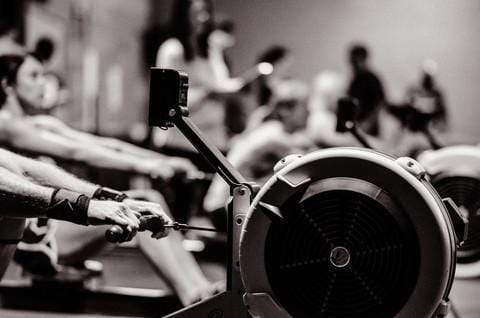CrossFitters are always looking to improve performance by working on weaknesses. (At least that’s what they should be doing.) Rowing is most likely one of them.
Why is rowing a part of CrossFit anyway? The best answer is taken from The CrossFit Journal Articles: “Rowing engages all the major muscles of the body and works multiple joints through a large range of motion in a natural, powerful sequence in a no-impact manner”. That’s what CrossFit is all about – using functional movements to work multiple joints.
And like almost every exercise that’s used in CrossFit, rowing is a science. Here are a few tips to help you improve on it.
- Body Position
Your body position is very important when rowing. It can make a difference on your performance. Proper positioning can keep you safe and injury free.
Hands, Arms, & Shoulders
When holding the handle on the rowing machine, don’t give it a death grip. You risk cramping your fingers and raising your blood pressure. Instead, wrap your fingers around the handle lightly. Your thumb should be wrapped under.
Make sure to keep the wrists straight. If you keep them bent, or keep bending them, while rowing you risk weakening your wrists. That defeats the purpose of CrossFitting. If you need a reminder, putting on your wrist wraps might help.
Keep your arms close to you. Don’t let the elbows flail out. When you keep the wrists straight, it helps the arms stay where they should.
Neck and shoulders should be relaxed. If you shrug your shoulders, you risk straining your neck. Keeping them relaxed will help improve your rowing.
Back & Abs
Your back should always stay strong. That means it should be straight. Once you start rounding the back, you start using it more than your legs. That’s not proper rowing technique.
Abs should be fully engaged during the drive and catch and firm during recovery.
At the start of rowing, you should be leaning slightly forward and when you finish, you should be leaning back slightly.
Feet, Knees, & Legs
When pulling the handle, push off with the heels just like when you’re deadlifting – you don’t lift the barbell while balancing on the balls of your feet, do you?
Knees should always be pointing up not out to the sides. Not keeping knees up is bad form and can compromise your rowing technique.
The legs are what do most of the work in rowing. Use them.
- The rowing movement
The motions of rowing is similar to the deadlift only you’re horizontal not vertical. The handle of the rowing machine should be traveling in a straight line. Here’s a breakdown:
Catch: Start in this position by leaning forward slightly with handle gripped loosely. Your shins should be vertical when you’re here. Remember to keep the shoulders relaxed.
Drive: Engage the legs by pushing with the heel. Keep your torso leaning forward slightly until you’re about to clear your knees. Once you’ve cleared your knees, start leaning back. Be sure not to layback too much. And then once your legs are fully extended, bring the elbows back. The handle comes toward your upper abdomen but it does not touch. To accomplish a good drive, the handle and seat need to move together.
Recovery: This is when you’re going back to the catch position. Straighten the arms then lean forward. As you’re clearing your knees, bend them. This part should be done deliberately slower than the drive. Ideally, you want the recovery to take twice as long as the drive.
- Breathing
You may not read about this much but how you breathe during rowing is important. You want to coordinate your breathing with your movement. This helps you get a good rowing cadence going. It also helps make the rowing smoother.
- Cadence
Ideally, you want to be between 22-26 strokes per minute. A good thing to note here is that strokes per minute has nothing to do with your height and everything to do with your technique.
Also, keep in mind that the damper setting on the side of the rowing machine is not for resistance as some might think. This setting is like the gears on a bicycle. You don’t use the gears on a bicycle for resistance. You use it to navigate hills and flat land easier.
If you set the damper at a high setting (8-10), it makes for longer muscular contraction and a slower stroke rating. If you set the damper at a low setting (1-3), it makes for fast and quick muscular contraction and a faster stroke rating. The ideal setting is 3-5 but you’ll still want to try the settings out and see which one allows you to get into the 22-26 strokes per minute range and keep it going for 20 minutes.
Rowing in itself is a great workout. Once you get your technique down, you’ll begin to appreciate a good cardio workout.
Josh Blackburn is NASM-CPT and Underground Strength Coach, who loves CrossFit, Strongman training, and helping people reach their athletic potential.

